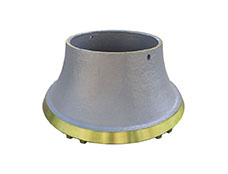+86 311 85258258
+86 311 85258258
Sep. 08, 2020
3. Heat treatment
High manganese steel casting can only obtain its characteristics under the right composition and correct heat treatment conditions. If it is not heat-treated or the heat treatment conditions are not correct, the steel will become brittle or even crack. The normal heat treatment specification is a solid solution plus high-temperature water toughening treatment in order to obtain a single austenite. Production practice proves that the solid solution temperature should be in the range of 1050-1090℃. It is generally believed that high-manganese steel has poor thermal conductivity and a low expansion rate. When solution treatment, slow heating should be used, and the temperature should be kept at 600-700°C to prevent cracking. The research results show that holding at 500-700℃ will cause the retained austenite to strongly precipitate carbides. These precipitates reduce the plasticity of the steel and increase the internal stress caused by the difference in specific volume between the new and old structures, thereby increasing the tendency of cracking. This temperature range should be passed as quickly as possible when heating.
4. Cleaning and cutting
One of the characteristics of high manganese steel is poor thermal conductivity, too short holding time after casting, and fast cooling speed, which promotes the increase of stress in the casting and is easy to crack. In order to prevent cracks, try to cool slowly in the sand mold to extend the holding time, and the boxing temperature should be controlled below 200°C. The practice has proved that no cracks appear in the box under this temperature. When cutting high manganese steel castings with risers and flash burrs, due to the poor thermal conductivity of the material, a large temperature difference is generated in the heat-affected zone of the cutting part and a high-stress state is formed. Slight neglect of the incision will cause cracks. In order to control the temperature difference in the heat-affected zone to a minimum, the pouring riser and burr cutting must be immersed and cut in the pool, and the water temperature is kept below 40°C so that the operation is not easy to produce cracks.

High Manganese Steel Casting
5. Repair welding
The effective way to eliminate defects in Metallurgy Machinery Parts is repair welding, and the possibility of cracks in the repair welding stage is also very high. In order to ensure product quality, the following issues must be paid attention to when repairing welding:
① No preheating is required before repair welding. Reheating at a lower temperature can cause carbides to precipitate along the grain boundaries and crystal planes, which promotes the reappearance of embrittlement and cracks.
②It is impossible to have satisfactory results for welding repair on manganese steel parts that have not been hydrothermally treated.
③To remove defects, try not to use flame cutting or carbon arc gouging, preferably air shovel and grinding wheel.
④ The composition of the repair welding electrode should be similar to that of the base metal, and the stainless steel electrode can also be used. No matter which type of electrode is used, the carbon content should be low, and the carbide precipitation can be reduced during repair welding.
⑤The part to be repaired should have a smooth surface, free of oil and rust, and repair the appropriate groove according to the welding repair process requirements.
⑥ The repair welding method is strictly implemented in accordance with the process.
⑦It is very important to avoid thermal stress that may cause cracks during repair welding. Due to the high coefficient of expansion and low thermal conductivity of manganese steel, stress will be generated at the repair weld during cooling. Therefore, the weld repair metal will be hammered during cooling to offset the compressive stress and the tensile stress generated during cooling.
⑧ Maintain the minimum heating of the parent metal during repair welding, which can minimize the adverse effects of reheating.